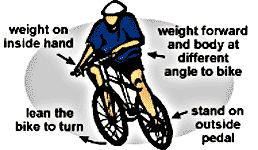|
Even at moderate speeds, you achieve most of your steering by leaning the bike, not yanking on the handle bars. The amount of turn depends on how far you lean the bike. Crank it right over for tight radius turns. Conversely, big long sweeping turns require only minimal bike lean.
Body lean
As you turn, nasty centrifugal forces conspire to flick you off your mount into the gorse bushes on the outside of the corner. Their strength depends on how fast you're travelling. So when you whip around a corner scary fast, you need to lean into it heaps (think about those crazies who race grand prix motor cycles around impossibly tight corners at ridiculous speeds). But because your velocity and the radius of the turn are rarely in perfect sync., you need to lean your bike and your body at different angles. Generally, this means leaning your bike into the turn and keeping your body slightly more upright. the turn are rarely in perfect sync., you need to lean your bike and your body at different angles. Generally, this means leaning your bike into the turn and keeping your body slightly more upright.
In traction
To carve out an elegant turn you've gotta speak proper and maintain traction on the front wheel. Do this by subtly moving your weight forward in the turn. Try splaying your elbows - this forces you forward and lowers your centre of gravity. You should almost be able to feel the old knobblies biting in. Beware: overdoing this while hairing down steep hills can result in the big full frontal endo. You also want to keep your weight over the "contact patch", ie. where the tyres meet the dirt. So try to put more weight on your inside hand and on the outside pedal - which you (obviously) must have placed at the bottom of its stroke.
For optimal cornering it pays to enter the corner at the right speed. Before the corner you can brake hard while you're still travelling in a straight line, but often you're forced to take evasive action once you're well and truly in the corner. Try using the back brake to scrub off speed - the front brake will generally force you and your bike to suddenly part company.
|